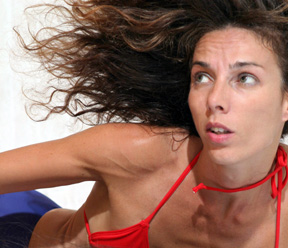Grappling with the Rubble
Keely
Garfield in “Disturbulance”
Dance Theatre Workshop,
New York. New York
Friday, January 28, 2005
by
Tom Phillips
copyright
© 2005 by Tom Phillips
 The
closer you were to the World Trade Center on September 11, 2001, the more
you have to work through, and choreographer Keely Garfield was right across
the street, where she lives. Still her new work, “Disturbulance,”
isn’t so much a personal as a political response—a look into
post-9/11 America, trying and failing to recover its faith.
The
closer you were to the World Trade Center on September 11, 2001, the more
you have to work through, and choreographer Keely Garfield was right across
the street, where she lives. Still her new work, “Disturbulance,”
isn’t so much a personal as a political response—a look into
post-9/11 America, trying and failing to recover its faith.
Garfield and Walter Dundervill are boy-and-girl twins who start out asleep, kneeling in long red-and-white sequined gowns with their heads on a blue plastic bench. Falling down together is the theme of their duet, to a “talking blues” by singer and guitarist Marc Ribot. The song is an ode to American enterprise and technology in the good old days when the world’s tallest building was a symbol of national triumph. It ends with a line about what we are today: angry people who can’t understand why someone would want to blow us up.
But blown up we are, and the twins are scrambling around, not so much in the rubble, but in the blank space left by the former ideas of American perfection and invincibility. The score is reduced to scratchy and skittery guitar riffs, including a hint of “London Bridge.” The dancers shed their sequined gowns, to reveal a matching shirt and skirt set—blue sky and floating clouds, which were all you could see after the smoke had cleared from the towers. Garfield repeatedly gapes upward at nothing, then at the audience in disbelief. What is to be done?
.jpg) The
twins try a bunch of stuff, including a little experimental incest, with
Garfield mugging over her partner’s shoulder, as if to say this
is interesting but not exactly the answer. He then puts her over his lap
and gives a fascist salute, which turns into a spanking. More mugging
from our heroine: hey, I’m not an evildoer! He tries to pull himself
up to see out a faux window, assisted by Garfield who drags the bench
over for him to stand on—the only helpful act I can recall in the
whole 45-minute piece. But finally they give up, strip off their shirts
and don rags, then crawl back to their bench, baaing like sheep. They
kneel, pull their red-and-white gowns over their heads, beat their fists
on the bench, then press their palms together in prayer. The piece ends
with Dundervill rolled up in a red blanket, and Garfield trying to prop
herself up against the wall. She falls, not sideways or forward, but vertically
onto her bum, like an imploding tower. Lights out.
The
twins try a bunch of stuff, including a little experimental incest, with
Garfield mugging over her partner’s shoulder, as if to say this
is interesting but not exactly the answer. He then puts her over his lap
and gives a fascist salute, which turns into a spanking. More mugging
from our heroine: hey, I’m not an evildoer! He tries to pull himself
up to see out a faux window, assisted by Garfield who drags the bench
over for him to stand on—the only helpful act I can recall in the
whole 45-minute piece. But finally they give up, strip off their shirts
and don rags, then crawl back to their bench, baaing like sheep. They
kneel, pull their red-and-white gowns over their heads, beat their fists
on the bench, then press their palms together in prayer. The piece ends
with Dundervill rolled up in a red blanket, and Garfield trying to prop
herself up against the wall. She falls, not sideways or forward, but vertically
onto her bum, like an imploding tower. Lights out.
For fans of pure dance there wasn’t much to marvel at, although Garfield showed she can command space in the brief moments when she detached herself from lockstep with her twin. For me, the best images were small-scale—Garfield’s facial takes, and a motif of rippling finger exercises. There was also a tiny erotic gesture that came off big—hooking just the top joint of her partner’s index finger into the cleavage of her shirt.
As political theatre, it was gripping for about the first half hour, until it became clear that this relationship wasn’t going anywhere. But give Garfield her due. Like wartime poet W.B. Yeats, she can “cast a cold eye on life, on death.”
The first part of the program was another duet, “Scent of Mental Love,” described as a “faux pas de deux” by the loquacious and witty choreographer, a native of London. This was a comically failed relationship played out by Paul Hamilton and Omagbitse Omagbemi, who begin by pulling on invisible ropes toward each other, and end by pulling on invisible ropes to opposite exits. In between they wrestle, somersault, sit on each other and fight, to a series of waltzes composed and sung by accordionist Rachelle Garniez. She is also an ace mugger, not just with her face but with her voice, which she uses to make fun of various sentimental styles, from country-western to cabaret to German-Swiss yodeling. “I love you, so you don’t love me,” she croons with impeccable neurotic logic. Choreographer Garfield gives her musician equal treatment with the dancers, moving her around the stage and front and center for one song, with the dancers in the background. Garniez earned the spotlight, making faux love with true soul on her squeezebox.
Photos:
Both of Keely Garfield by Julieta Cervantes
Volume
3, No. 5
January 31, 2005
www.danceviewtimes.com
Copyright
©2005 by Tom Phillips
|
|
|